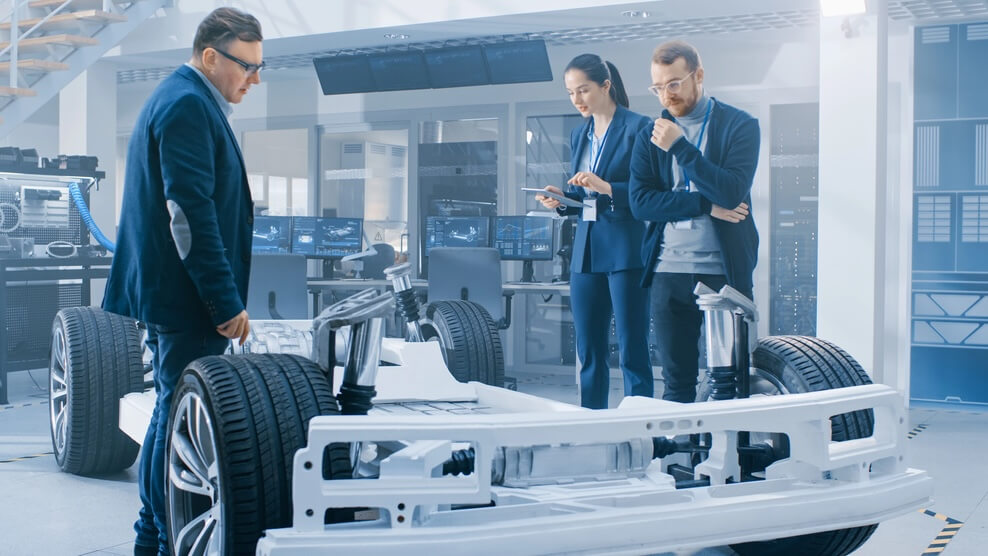The Canada-U.S. trade war has put car manufacturing directly in the crosshairs. Previously, car manufacturing was the gold star of cross-border cooperation, with car parts manufactured travelling back and forth across the Canadian, U.S. and Mexican borders multiple times before a car was completed and ready for purchase. Those days, it seems, are now behind us.
As Canada re-envisions the car industry, including ramping up parts manufacturing in our own country, engineers have a critical role to play.
Engineers have helped drive innovation in the Canadian car industry before — and we can do it again. A look at our past can help energize the future.
When you get behind the wheel of a car, it’s easy to overlook the decades of innovation that made your journey possible. From early transportation developments to cutting-edge systems in modern vehicles, each component reflects generations of human ingenuity. Our smooth, reliable driving experience results from countless engineering breakthroughs in design, safety, efficiency and performance.
The first automobile emerged in the late 19th century when engineers refined combustion engines and developed the first gasoline-powered car. As the industry advanced, Oshawa, Ontario emerged as a central hub in Canada’s automotive sector. Here, the McLaughlin family transitioned from carriage-making to automobile manufacturing by 1907, laying the foundation for General Motors of Canada — one of the country’s largest automotive manufacturers and a key player in the global industry.
This early shift from carriage-making to automobile manufacturing sparked a broader societal transformation. Over the past century, cars have transitioned from being luxury items to essential fixtures in our daily lives.
Engineering disciplines have converged to enhance structural integrity, optimize mechanical performance and introduce comfort features like air conditioning, GPS and assistive driving technologies. Today, automobiles are not merely a means of transportation; they are integral to modern life, providing convenience, comfort and advanced technology that shape how we live, work and interact with the world.
As the industry continues to evolve, engineers are increasingly focused on economic and ecological efficiency, driving the design of lighter, more sustainable vehicles.
Early vehicles were made from cast iron, steel and wood — materials borrowed from carriage manufacturing. By reducing vehicle weight, cars now require less power and fuel for acceleration, benefiting the environment through a smaller carbon footprint, and consumers, through lower fuel costs.
The forces of globalization have further fueled innovation. This competitive environment has pushed manufacturers to meet strict global environmental and safety regulations, driving technological progress. Engineers, fronted with rising sustainability and affordability demands, have embraced these challenges as opportunities for creativity.
Amid this landscape, Canada’s automotive industry has not only been a hub for innovation but also a driver of economic prosperity.
According to Statistics Canada, the industry plays a vital role in manufacturing and infrastructure development, with 26.3 million registered motor vehicles in 2022 and motor vehicle and parts manufacturing generating $109.5 million in revenue in 2023 — underscoring its impact on mobility, job creation and economic growth.
As the industry shifts toward electric and autonomous vehicles, Canadian institutions and research centres are shaping the future of transportation. Their work focuses on advancing electric and hydrogen-powered vehicle technologies, strengthening supply chain resilience and promoting sustainable manufacturing.
Specialized research centres are accelerating this progress. At Ontario Tech University, the ACE Core Research Facility, home to one of the world’s most sophisticated climatic wind tunnels, advances extreme-condition vehicle testing, helping manufacturers develop more resilient, efficient and sustainable transportation solutions.
Facilities like ACE bolster Canada’s position as an automotive innovation leader, attract global manufacturers, create high-skilled jobs and drive economic growth.
This momentum is supported by broader initiatives, such as Project Arrow — the first all-Canadian zero-emission vehicle — designed, engineered and built through collaboration between Canada’s top-tier automotive supply sector and post-secondary institutions.
Ontario’s 2019 Driving Prosperity Plan reinforces the province’s commitment to automotive excellence through engineering expertise and technological advancements. GM’s $1.3 billion investment in Oshawa’s plant and Hydro One and Ontario Power Generation’s installation of fast chargers for electric vehicles depend on ongoing engineering developments.
As automakers invest billions in electrification, engineers keep Canada a key player in the global automotive economy — positioning Canada as a leader in next-generation vehicle production and development.
Photo courtesy of DepositPhoto




